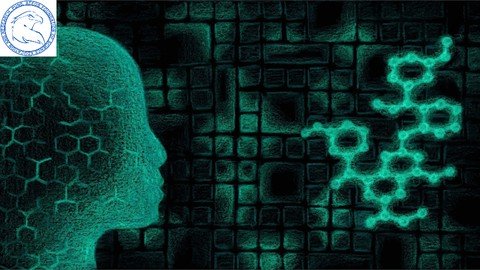
Published 6/2022
MP4 | Video: h264, 1280x720 | Audio: AAC, 44.1 KHz
Language: English | Size: 1.06 GB | Duration: 2h 3m
SDBB, LBDD, Pharmacophore Modelling, QSAR, Combinatorial Chemistry
What you'll learn
To make the learner aware about basics of Computer Aided Drug Design (CADD)
To make the learner aware about basics of Structure Based Drug Design
To make the learner aware about basics of Databases used in Drug Design
To make the learner aware about basics of Ligand Based Drug Design
Requirements
Basics of Organic Chemistry, Biochemistry, Medicinal Chemistry, Pathophysiology and Information Technology
Description
Computer Aided Drug DesignThe most fundamental goal in drug design is to predict whether a given molecule will bind to a target and if so how strongly. Molecular mechanics or molecular dynamics is most often used to estimate the strength of the intermolecular interaction between the small molecule and its biological target. These methods are also used to predict the conformation of the small molecule and to model conformational changes in the target that may occur when the small molecule binds to it. Semi-empirical, ab initio quantum chemistry methods, or density functional theory are often used to provide optimized parameters for the molecular mechanics calculations and also provide an estimate of the electronic properties (electrostatic potential, polarizability, etc.) of the drug candidate that will influence binding affinityMolecular mechanics methods may also be used to provide semi-quantitative prediction of the binding affinity. Also, knowledge-based scoring function may be used to provide binding affinity estimates. These methods use linear regression, machine learning, neural nets or other statistical techniques to derive predictive binding affinity equations by fitting experimental affinities to computationally derived interaction energies between the small molecule and the target.Ideally, the computational method will be able to predict affinity before a compound is synthesized and hence in theory only one compound needs to be synthesized, saving enormous time and cost. The reality is that present computational methods are imperfect and provide, at best, only qualitatively accurate estimates of affinity. In practice it still takes several iterations of design, synthesis, and testing before an optimal drug is discovered. Computational methods have accelerated discovery by reducing the number of iterations required and have often provided novel structures.Drug design with the help of computers may be used at any of the following stages of drug discovery:1. hit identification using virtual screening (structure- or ligand-based design)2. hit-to-lead optimization of affinity and selectivity (structure-based design, QSAR, etc.)3. lead optimization of other pharmaceutical properties while maintaining affinityIn order to overcome the insufficient prediction of binding affinity calculated by recent scoring functions, the protein-ligand interaction and compound 3D structure information are used for analysis. For structure-based drug design, several post-screening analyses focusing on protein-ligand interaction have been developed for improving enrichment and effectively mining potential candidates:· Consensus scoringo Selecting candidates by voting of multiple scoring functionso May lose the relationship between protein-ligand structural information and scoring criterion· Cluster analysiso Represent and cluster candidates according to protein-ligand 3D informationo Needs meaningful representation of protein-ligand interactionsContents include:Introduction to basics concept of Drug DesignComputer Aided Drug DesignTypes of SBDDSteps in CADDPharmacophore ModellingQSARCombinatorial ChemistryThe Hands on Experience to the CADD for SBDD can be obtained from Prescience In silico Pvt Ltd
Overview
Section 1: Introduction
Lecture 1 Introduction
Section 2: Computer Aided Drug Design
Lecture 2 Computer Aided Drug Design
Lecture 3 Types of Databases
Lecture 4 Types of SBDD (Structure Based Drug Design)
Lecture 5 CADD Steps
Section 3: Ligand Based Drug Design
Lecture 6 Pharmacophore Modelling
Lecture 7 QSAR
ALL Levels of Science, Pharmacy, Bioinformatics and Chemo-informatics Graduates and Undergraduates
Homepage
https://www.udemy.com/course/certificate-course-in-computer-aided-drug-design/
https://rapidgator.net/file/1c3c183922723ab20a35ee90ab9e75d5/jtqzn.Certificate.Course.In.Computer.Aided.Drug.Design.part1.rar.html
https://rapidgator.net/file/74afb5a89f51990ea1ef0c1279062834/jtqzn.Certificate.Course.In.Computer.Aided.Drug.Design.part2.rar.html
H4S
https://hot4share.com/ld68jquf3v0l/jtqzn.Certificate.Course.In.Computer.Aided.Drug.Design.part2.rar.html
https://hot4share.com/p2hlgnemy98m/jtqzn.Certificate.Course.In.Computer.Aided.Drug.Design.part1.rar.html

https://nitro.download/view/0A2EC6B12006A5D/jtqzn.Certificate.Course.In.Computer.Aided.Drug.Design.part1.rar
https://nitro.download/view/C986042634D84B5/jtqzn.Certificate.Course.In.Computer.Aided.Drug.Design.part2.rar

https://uploadgig.com/file/download/2dca8CdB9ec1AE7a/jtqzn.Certificate.Course.In.Computer.Aided.Drug.Design.part2.rar
https://uploadgig.com/file/download/7b7a26e19B89381d/jtqzn.Certificate.Course.In.Computer.Aided.Drug.Design.part1.rar
 Views: 15
Views: 15  Comments (0)
Comments (0)
free Certificate Course In Computer Aided Drug Design, Downloads Certificate Course In Computer Aided Drug Design, RapidShare Certificate Course In Computer Aided Drug Design, Megaupload Certificate Course In Computer Aided Drug Design, Mediafire Certificate Course In Computer Aided Drug Design, DepositFiles Certificate Course In Computer Aided Drug Design, HotFile Certificate Course In Computer Aided Drug Design, Uploading Certificate Course In Computer Aided Drug Design, Easy-Share Certificate Course In Computer Aided Drug Design, FileFactory Certificate Course In Computer Aided Drug Design, Vip-File Certificate Course In Computer Aided Drug Design, Shared Certificate Course In Computer Aided Drug Design, Please feel free to post your Certificate Course In Computer Aided Drug Design Download, Movie, Game, Software, Mp3, video, subtitle, sample, torrent, NFO, Crack, uploaded, putlocker, Rapidgator, mediafire, Netload, Zippyshare, Extabit, 4shared, Serial, keygen, Watch online, requirements or whatever-related comments here.
Related Downloads :


